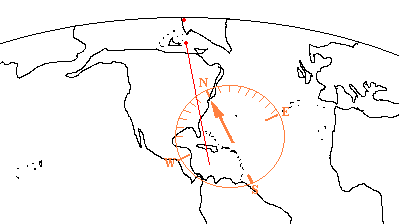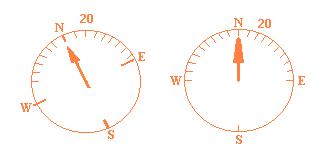Magnetic Variations
Magnetic Variations
|
Magnetic Variation: possibly the most bogus theory of them all. When
the Coast Guard put their name on this theory they neutered a lot
of their credibility. No one had heard about this theory until the
Coast Guard put out a little hastily written chit about 30 years ago,
stating their position on the subject of the Bermuda Triangle. It reads, in part: Countless theories attempting to explain the many disappearances have been offered throughout the history of the area. The most practical seem to be environmental and those citing human error. The majority of disappearances can be attributed to the area's unique environmental features. First, the "Devil's Triangle" is one of the two places on earth that a magnetic compass does point towards true north. Normally it points toward magnetic north. The difference between the two is known as compass variation. The amount of variation changes by as much as 20 degrees as one circumnavigates the earth. If this compass variation or error is not compensated for, a navigator could find himself far off course and in deep trouble.
This is a very misleading statement. For one, the area of no compass
variation is a very narrow corridor, tantamount to a fraction of
the overall Triangle. It also overlooks the fact that one cannot
even plot a course without having a navigational chart, and all
navigational charts have the amount of variation written on them
for every degree of longitude. Before a navigator could even chart
a course he would have to know the amount of variation. This also
overlooks the large number of disappearances of pilots and skippers
who were old hands in this part of the world, being charter pilots
and the like. They were very familiar with local variation. |
|
| ||||||||||||||||||
| | lead you to the North Pole; it will lead you to Prince of Wales Island. See illustration. |
|
|
| | |
| To compensate for this, the navigator must know the number of degrees of difference between Magnetic North and True North in his longitude. This changes according to one's longitude around the earth. For instance, at the Azores Islands there is a 20 degree difference between True North and Magnetic North. Off the east coast of Florida, there is none. The compass is still pointing to Magnetic North. It just so happens that True North is directly north of here. See illustration. |
|
|
| | |
| Except for this narrow corridor, there is always some form of compensation the navigator must go through.* For example, at the Azores, if a navigator wanted to go straight north, he could not follow the N on his compass. If he did, he would end up in Canada and not in Greenland. So he heads 020 degrees and now he is heading True north. That is what Compass Variation means: the amount of difference between the North Pole and the Magnetic North Pole at a given location. The result is a simple navigational adjustment to stay on course. |
|
|
| | |
|
This amount of variation will decrease the further one travels West
until one reaches the Agonic Line. Soon after, the amount of variation
will increase again, with the compass pointing Easterly of True North.
There is little reason to suppose that this has contributed to any loss. Failure to compensate the amount of variation correctly can cause a pilot to get lost anywhere in the world, whether there is no degree variation to compensate for or 15 degrees. One degree off can, over time, result in many miles in error, making a pilot miss his intended destination. But as I said this can happen anywhere in the world. The Triangle does not stand out as unique because there is no variation in degrees to calculate for a brief period in a very narrow corridor of it. I try and list theories objectively. But in this case a dead horse is a dead horse. There is no merit to this theory at all. A further factor contributing to this deduction is that the Agonic Line moves as the magnetic pole shifts, due to many factors in the rotation of the earth. Over time the Agonic Line can be miles from where it was. Actually every 2 months or so a flight is manned and sent to find the magnetic pole. The upshot is that the Agonic Line is not in the strict Triangle anymore. It is located off the west coast of Florida. Technically, still in the Triangle because the Keys are considered a part of it. The artwork and maps above show the Agonic Line where it was when the Coast Guard made up their little chit about 30 years ago. Magnetic Variation was not a satisfactory explanation before. It is even more passť now. Disappearances still occur in the same places as before, even though the Line is on the other side of Florida now.
*Yes I know it happens on the exact other side of the world; but that is not relevant here so we can dispense with it in this article. |
| |






